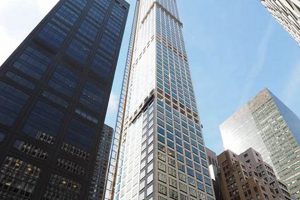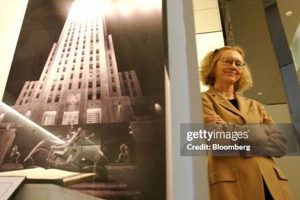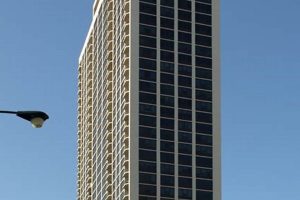Skyscrapers in Malaysia are towering structures that define the skylines of major cities like Kuala Lumpur, Penang, and Johor Bahru. These architectural marvels symbolize the country’s economic growth and modernization.
The iconic Petronas Towers in Kuala Lumpur, once the world’s tallest buildings, stand as a testament to Malaysia’s engineering prowess. Other notable skyscrapers include The Exchange 106, KLCC, and Menara Telekom, each offering stunning views and housing prestigious offices, hotels, and retail spaces.
The construction of skyscrapers in Malaysia serves several purposes. They accommodate the growing population density in urban areas, provide efficient office spaces for businesses, and contribute to the country’s tourism industry by offering observation decks and upscale amenities. Moreover, these architectural landmarks enhance the overall aesthetics and prestige of Malaysian cities.
Overall, skyscrapers in Malaysia are more than just buildings; they are symbols of progress, ambition, and the country’s evolving skyline.
1. Height
The height of skyscrapers in Malaysia is a defining characteristic that showcases the country’s architectural prowess and ambition. These towering structures push the boundaries of engineering, requiring innovative designs and cutting-edge construction techniques to ensure stability and safety. The Petronas Towers, for example, were once the tallest buildings in the world, a testament to Malaysia’s engineering capabilities.
The height of skyscrapers also has practical significance. It allows for efficient use of land space in densely populated urban areas. By building upwards, skyscrapers can accommodate more people and businesses without sprawling outwards. Additionally, the height of these buildings often offers panoramic views, making them attractive for offices, residential units, and tourism.
In conclusion, the height of skyscrapers in Malaysia is not merely a matter of aesthetics but a reflection of the country’s architectural advancements and a practical solution to accommodate growth and urbanization.
2. Design
The design of skyscrapers in Malaysia is not just about aesthetics but also about innovation and functionality. Architects push the boundaries of design to create captivating structures that are both visually stunning and practical. The Petronas Towers, for example, are a prime example of innovative design, featuring a unique twin-tower structure connected by a skybridge. This design not only creates a striking visual effect but also allows for efficient use of space and resources.
The incorporation of sustainable features is another important aspect of skyscraper design in Malaysia. Many skyscrapers are designed to be eco-friendly, using energy-efficient systems, recycled materials, and green spaces. This focus on sustainability not only reduces the environmental impact of these buildings but also aligns with the country’s commitment to environmental protection.
Overall, the design of skyscrapers in Malaysia is a testament to the country’s architectural ingenuity and commitment to innovation and sustainability. These buildings are not just landmarks but also symbols of Malaysia’s progress and ambition.
3. Engineering
The engineering behind skyscrapers in Malaysia is crucial to their success and safety. These towering structures are built to withstand the elements, including strong winds, earthquakes, and even fires. Cutting-edge technology is used to ensure the stability and integrity of these buildings, making them safe for occupants and visitors alike.
One of the key challenges in skyscraper engineering is ensuring that the building can withstand strong winds. Malaysia is located in a region prone to typhoons and other severe storms, so skyscrapers must be designed to withstand high wind loads. Engineers use a variety of techniques to achieve this, such as using reinforced concrete and steel frames, and incorporating aerodynamic features into the building’s design.
Another challenge is ensuring that skyscrapers can withstand earthquakes. Malaysia is not located in a major earthquake zone, but it is still possible for earthquakes to occur. Engineers use a variety of techniques to mitigate the effects of earthquakes, such as using base isolation systems and energy dissipation devices.
Fire safety is also a major concern in skyscraper design. Skyscrapers are often filled with flammable materials, so it is important to have a comprehensive fire safety plan in place. Engineers use a variety of techniques to prevent and suppress fires, such as using fire-resistant materials, installing smoke detectors and sprinklers, and providing multiple escape routes.
4. Green Features
Incorporating green features into the design of skyscrapers in Malaysia is a crucial step towards reducing their environmental impact and promoting sustainability. Architects and engineers are increasingly recognizing the importance of eco-friendly building practices, and skyscrapers are no exception. By implementing green features, skyscrapers can minimize their carbon footprint, conserve natural resources, and create healthier indoor environments for occupants.
One of the key green features employed in Malaysian skyscrapers is the use of energy-efficient systems. This includes optimizing lighting systems, using renewable energy sources such as solar and wind power, and implementing smart building technologies to manage energy consumption. The Menara Prudential, for example, is equipped with a rainwater harvesting system, a solar photovoltaic system, and energy-efficient lighting, resulting in significant energy savings.
Another important aspect of green skyscraper design is the use of sustainable materials. This involves choosing materials that have a low environmental impact, such as recycled steel and glass, and using them in a responsible manner. The Exchange 106, one of the tallest buildings in Malaysia, is a notable example of sustainable material usage. Its faade is made from recycled glass, and the building incorporates recycled steel in its construction.
5. Mix-Use
The mix-use nature of skyscrapers in Malaysia is a key factor in their contribution to vibrant urban hubs. By combining offices, reside
nces, and retail spaces within a single structure, these buildings create a diverse and dynamic environment that attracts people from all walks of life. This mix-use approach not only enhances the overall functionality of the building but also fosters a sense of community and convenience.
- Vertical Communities
Skyscrapers with mixed-use spaces create vertical communities where people live, work, and play in the same building. This fosters a sense of belonging and encourages social interactions among residents, office workers, and visitors. The KLCC area in Kuala Lumpur is a prime example of a vibrant vertical community, with the Petronas Towers, Suria KLCC shopping mall, and numerous residential units all interconnected.
- 24/7 Activity
The mix of uses in skyscrapers ensures a constant flow of activity throughout the day and night. Office workers during the day, shoppers in the evening, and residents at all hours create a lively and energetic atmosphere. This 24/7 buzz contributes to the overall vitality and safety of the surrounding urban area.
- Reduced Traffic Congestion
By providing a mix of amenities within a single building, skyscrapers reduce the need for people to travel long distances for different purposes. This helps alleviate traffic congestion and promotes a more sustainable and walkable urban environment. The Tun Razak Exchange (TRX) in Kuala Lumpur is a good example of how mixed-use skyscrapers can help reduce traffic congestion by providing a range of amenities within easy walking distance.
- Enhanced Economic Vitality
The mix-use nature of skyscrapers attracts a diverse range of businesses and residents, contributing to the economic vitality of the surrounding area. The presence of office spaces, retail outlets, and residential units creates a demand for goods, services, and amenities, leading to the growth of local businesses and the creation of employment opportunities.
In conclusion, the mix-use nature of skyscrapers in Malaysia plays a crucial role in creating vibrant urban hubs. By combining different functions within a single structure, these buildings foster a sense of community, enhance convenience, reduce traffic congestion, and contribute to the economic vitality of the surrounding area.
6. Tourism
Skyscrapers in Malaysia are not just architectural marvels; they are also popular tourist destinations. Many of these buildings offer observation decks and other attractions that provide breathtaking views of the city and surrounding landscapes. This section explores the connection between skyscrapers and tourism in Malaysia, highlighting key facets that contribute to their popularity among visitors.
- Observation Decks
Observation decks are a major draw for tourists visiting skyscrapers in Malaysia. These decks offer panoramic views of the city, allowing visitors to take in the sights and landmarks from a unique perspective. The Petronas Towers, for example, feature a double-decker observation deck on the 86th and 87th floors, providing visitors with stunning views of Kuala Lumpur.
- Sky Bars and Restaurants
Many skyscrapers in Malaysia house sky bars and restaurants that offer a combination of fine dining and breathtaking views. These venues provide a unique and sophisticated experience for visitors, who can enjoy cocktails or meals while taking in the city lights. The Atmosphere 360 revolving restaurant in the KL Tower is a notable example, offering diners a 360-degree view of Kuala Lumpur.
- Rooftop Pools and Gardens
Some skyscrapers in Malaysia feature rooftop pools and gardens that provide visitors with a relaxing and luxurious experience. These amenities allow guests to escape the hustle and bustle of the city and enjoy the views from a tranquil setting. The rooftop infinity pool at the Four Seasons Hotel Kuala Lumpur is a popular spot for tourists and locals alike.
- Shopping and Entertainment
Many skyscrapers in Malaysia are integrated with shopping malls and entertainment venues. This combination provides visitors with a convenient and enjoyable experience, allowing them to shop, dine, and be entertained all under one roof. The Suria KLCC shopping mall, located at the base of the Petronas Towers, is a popular destination for tourists and locals, offering a wide range of retail options and entertainment facilities.
In conclusion, the connection between skyscrapers and tourism in Malaysia is evident in the various attractions and amenities that these buildings offer. Observation decks, sky bars, rooftop pools, shopping malls, and entertainment venues all contribute to the popularity of skyscrapers as tourist destinations. These attractions provide visitors with unique experiences and breathtaking views, making them a must-visit for anyone exploring Malaysia’s urban landscapes.
7. Economic Drivers
Skyscrapers in Malaysia serve as economic drivers, contributing to the country’s economic growth and development. Their towering presence in major cities attracts businesses and investments from both domestic and international sources, leading to a multiplier effect that benefits various sectors of the economy. This section delves into the connection between skyscrapers and economic growth in Malaysia, exploring the importance of skyscrapers as economic catalysts.
One of the key ways in which skyscrapers contribute to economic growth is by providing modern and efficient office spaces for businesses. The availability of Grade A office space in skyscrapers attracts multinational corporations and financial institutions, which establish their regional headquarters or operations in Malaysia. This influx of businesses creates job opportunities, stimulates economic activity, and contributes to the country’s GDP. The Petronas Towers, for example, house the offices of numerous international companies, including IBM, Microsoft, and Reuters, showcasing the role of skyscrapers in attracting foreign direct investment.
Moreover, skyscrapers serve as symbols of economic progress and development, enhancing the overall investment climate of the country. Their iconic designs and architectural prowess attract investors who are keen on participating in Malaysia’s growth story. The construction and maintenance of skyscrapers generate employment opportunities in various sectors, such as construction, engineering, and property management, further contributing to economic growth.
In addition, skyscrapers often incorporate mixed-use developments that include retail, hospitality, and residential components. These mixed-use developments create vibrant urban hubs that attract tourists and residents, boosting the retail, tourism, and real estate sectors. The KLCC area surrounding the Petronas Towers is a prime example of a thriving mixed-use development that has spurred economic growth and transformed the city’s skyline.
In conclusion, the connection between skyscrapers and economic growth in Malaysia is undeniable. Skyscrapers serve as economic drivers by attracting businesses and investments, providing modern office spaces, symbolizing economic progress, and creating employment opportunities in various sectors. Understanding this connection is crucial for policymakers, investors, and businesses seeking to capitalize on the economic benefits that sk
yscrapers bring to the country.
8. Cultural Landmarks
Skyscrapers in Malaysia have transcended their functional purpose and become iconic cultural landmarks that embody the country’s aspirations and national pride. These towering structures serve as symbols of Malaysia’s economic progress, architectural prowess, and cultural heritage, leaving an indelible mark on the country’s identity.
The Petronas Towers, the world’s tallest twin towers upon their completion in 1998, stand as a prime example of how skyscrapers can become cultural landmarks. Their unique design, inspired by Islamic motifs, has made them an instantly recognizable symbol of Kuala Lumpur and Malaysia as a whole. The towers have been featured in countless films, television shows, and other media, solidifying their status as cultural icons.
Beyond their aesthetic appeal, skyscrapers in Malaysia often incorporate elements of traditional Malaysian culture and heritage into their design. The Menara Kuala Lumpur, also known as the KL Tower, features a distinctive latticework pattern inspired by traditional Malay craftmanship. Thisof modern architecture with cultural elements creates a sense of place and cultural pride among Malaysians.
The practical significance of understanding the connection between skyscrapers and cultural landmarks lies in its ability to foster a sense of national identity and unity. These iconic structures serve as symbols of what Malaysia has achieved and inspire a sense of pride and belonging among its citizens. Moreover, skyscrapers can attract tourists and international recognition, showcasing Malaysia’s architectural achievements and cultural heritage to the world.
In conclusion, the connection between skyscrapers and cultural landmarks in Malaysia is a testament to the power of architecture to transcend its functional purpose and become symbols of national identity and pride. By incorporating cultural elements into their design and serving as iconic landmarks, skyscrapers in Malaysia contribute to the country’s cultural heritage and foster a sense of unity among its citizens.
FAQs on Malaysia Skyscrapers
Skyscrapers in Malaysia have become iconic landmarks and symbols of the country’s economic progress. Here are answers to some frequently asked questions about these towering structures:
Question 1: What is the tallest skyscraper in Malaysia?
Answer: The tallest skyscraper in Malaysia is Merdeka 118, standing at 678.9 meters tall. It surpassed the Petronas Towers, which held the title for over two decades.
Question 2: What are the key architectural features of Malaysian skyscrapers?
Answer: Malaysian skyscrapers often incorporate elements of traditional Malay culture and heritage into their design. They may feature intricate latticework patterns, geometric motifs, and the use of natural materials like bamboo and timber.
Question 3: Are skyscrapers in Malaysia earthquake-resistant?
Answer: Yes, skyscrapers in Malaysia are designed to withstand earthquakes. Engineers use advanced technologies and building techniques to ensure the structural integrity of these buildings during seismic events.
Question 4: What are the environmental considerations in the construction of skyscrapers in Malaysia?
Answer: Many skyscrapers in Malaysia are designed with sustainability in mind. They incorporate energy-efficient systems, use recycled materials, and employ green building practices to reduce their environmental impact.
Question 5: How do skyscrapers contribute to the economic development of Malaysia?
Answer: Skyscrapers attract businesses and investments, providing modern office spaces and mixed-use developments. This stimulates economic growth, creates employment opportunities, and enhances the country’s overall investment climate.
Question 6: What is the cultural significance of skyscrapers in Malaysia?
Answer: Skyscrapers in Malaysia have become cultural icons, representing the country’s aspirations and national pride. They serve as symbols of economic progress, architectural prowess, and the of modern and traditional design.
In summary, skyscrapers in Malaysia are not just buildings; they are testaments to the country’s economic strength, architectural ingenuity, and cultural heritage.
Transition to the next article section:
Tips on Visiting Skyscrapers in Malaysia
Skyscrapers in Malaysia offer breathtaking views and unique experiences. Here are some tips to make the most of your visit:
Tip 1: Purchase tickets in advance.
Popular skyscrapers like the Petronas Towers and KL Tower often have long queues. Avoid disappointment by purchasing tickets online or through authorized agents.
Tip 2: Arrive early.
Arrive at the skyscraper early to avoid crowds and secure a spot near the windows for the best views. This is especially important during peak tourist seasons.
Tip 3: Dress appropriately.
Most skyscrapers have dress codes, so avoid wearing shorts, slippers, or revealing clothing. Respect the cultural norms and dress modestly.
Tip 4: Take your time.
Don’t rush your visit. Take your time to admire the views, explore the observation decks, and learn about the architectural marvels of these skyscrapers.
Tip 5: Bring your camera.
Capture the stunning panoramic views and architectural details of the skyscrapers. Remember to follow any photography guidelines set by the management.
Tip 6: Check for special events.
Some skyscrapers host special events like guided tours, exhibitions, or rooftop dining experiences. Check their websites or social media pages for upcoming events to enhance your visit.
Tip 7: Respect the rules.
Follow the instructions provided by the staff and security personnel. Refrain from touching or leaning on the glass panels, and be mindful of other visitors.
Tip 8: Enjoy the experience.
Visiting skyscrapers in Malaysia is a unique and memorable experience. Soak in the breathtaking views, appreciate the architectural wonders, and enjoy the moment.
These tips will help you make the most of your visit to Malaysia’s iconic skyscrapers, ensuring a safe, enjoyable, and unforgettable experience.
Transition to the article’s conclusion:
Conclusion
Skyscrapers in Malaysia are more than just towering structures; they are symbols of the country’s economic development, architectural prowess, and cultural heritage. They have transformed Malaysia’s skylines, attracted businesses and investments, and become iconic landmarks that embody national pride.
The exploration of Malaysia’s skyscrapers in this article has highlighted their multifaceted nature, from their architectural design and engineering marvels to their contributions to the economy and cultural significance. These skyscrapers are not only functional buildings but also testaments to Malaysia’s progress and ambition.
As Malaysia continues to grow and evolve, its skyscrapers will undoubtedly continue to play a vital role in shaping the country’s future. They will serve as symbols of progress, innovation, and the nation’s unwavering determination to reach new heights.







